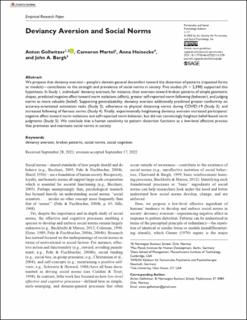Deviancy Aversion and Social Norms
| dc.contributor.author | Gollwitzer, Anton | |
| dc.contributor.author | Martel, Cameron | |
| dc.contributor.author | Heinecke, Anna | |
| dc.contributor.author | Bargh, John | |
| dc.date.accessioned | 2023-01-09T13:37:53Z | |
| dc.date.available | 2023-01-09T13:37:53Z | |
| dc.date.created | 2022-12-15T13:39:30Z | |
| dc.date.issued | 2022 | |
| dc.identifier.issn | 0146-1672 | |
| dc.identifier.uri | https://hdl.handle.net/11250/3042022 | |
| dc.description.abstract | We propose that deviancy aversion—people’s domain-general discomfort toward the distortion of patterns (repeated forms or models)—contributes to the strength and prevalence of social norms in society. Five studies (N = 2,390) supported this hypothesis. In Study 1, individuals’ deviancy aversion, for instance, their aversion toward broken patterns of simple geometric shapes, predicted negative affect toward norm violations (affect), greater self-reported norm following (behavior), and judging norms as more valuable (belief). Supporting generalizability, deviancy aversion additionally predicted greater conformity on accuracy-orientated estimation tasks (Study 2), adherence to physical distancing norms during COVID-19 (Study 3), and increased following of fairness norms (Study 4). Finally, experimentally heightening deviancy aversion increased participants’ negative affect toward norm violations and self-reported norm behavior, but did not convincingly heighten belief-based norm judgments (Study 5). We conclude that a human sensitivity to pattern distortion functions as a low-level affective process that promotes and maintains social norms in society | en_US |
| dc.language.iso | eng | en_US |
| dc.publisher | Sage | en_US |
| dc.rights | Navngivelse-Ikkekommersiell 4.0 Internasjonal | * |
| dc.rights.uri | http://creativecommons.org/licenses/by-nc/4.0/deed.no | * |
| dc.subject | deviancy aversion | en_US |
| dc.subject | broken patterns | en_US |
| dc.subject | social norms | en_US |
| dc.subject | social cognition | en_US |
| dc.title | Deviancy Aversion and Social Norms | en_US |
| dc.title.alternative | Deviancy Aversion and Social Norms | en_US |
| dc.type | Peer reviewed | en_US |
| dc.type | Journal article | en_US |
| dc.description.version | publishedVersion | en_US |
| dc.source.journal | Personality and Social Psychology Bulletin | en_US |
| dc.identifier.doi | 10.1177/01461672221131378 | |
| dc.identifier.cristin | 2093790 | |
| cristin.ispublished | true | |
| cristin.fulltext | postprint | |
| cristin.qualitycode | 2 |
Tilhørende fil(er)
Denne innførselen finnes i følgende samling(er)
-
Scientific articles [2181]

